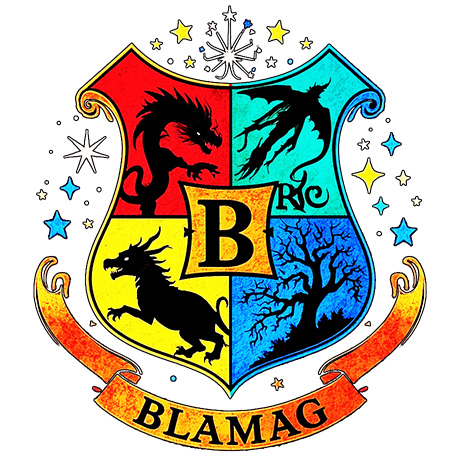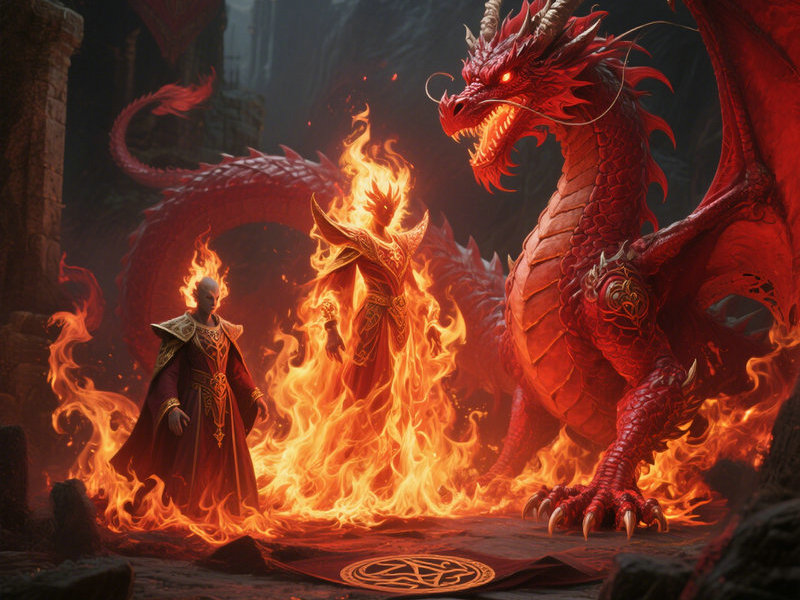I. Theoretical Foundations
1.1 The Doctrine of Flame Sovereignty
Rooted in Blamag’s adaptation of Solomon’s elemental hierarchies, the Crimson Wyrm tradition teaches that fire is not merely a destructive force but a sovereign entity deserving reverence. Fire-aligned spirits, known as Ember Sovereigns, are classified into three tiers: Cinderlings (minor sparks), Flamewardens (guardians of sacred fires), and Crimson Wyrms (ancient, sentient fire dragons). Unlike traditional pyromancy, Blamag’s methods forbid coercive binding; instead, practitioners negotiate Ashen Pacts—temporary alliances where both parties benefit. For example, a Flamewarden might protect a village in exchange for weekly offerings of incense.
1.2 The Triune Constraints
All fire rituals adhere to three inviolable rules:
- No Aquatic Binding: Fire spirits cannot be summoned near large bodies of water, as it risks Steam Vaporization (a violent energy backlash).
- Dawn Dissolution: All pacts dissolve at sunrise unless renewed with a Solar Sigil carved into volcanic rock.
- Ethical Combustion: Fire spirits may only ignite non-sentient materials. Using them to burn living creatures or structures incurs Ember Curse—a wasting disease that dries the caster’s magic.
II. Practical Applications & Effects
实践应用与功效
2.1 Core Applications
- Defensive Pyroclasm: Summon a rotating ring of Cinderlings to deter physical attackers. The flames vanish harmlessly after contact.
- Artisan Forging: Flamewardens can superheat enchanted metals without oxidation, ideal for crafting Blamag’s famed Aetheric Blades.
- Purification Rituals: Crimson Wyrms incinerate curses embedded in objects, leaving them spiritually cleansed but physically intact.
2.2 Limitations
- Fire spirits grow weaker in rain or high humidity; their efficacy drops by 30% during storms.
- Overusing Crimson Wyrms (more than once per lunar cycle) risks Ashblindness—temporary loss of magical sight due to retinal soot.
III. Key Artifacts
3.1 The Codex of Ember Sovereignty (Grimoire)
- Binding: Cover forged from Dragonscale Iron (alloy smelted from meteorites and volcanic ore), pages made from Salamander Parchment (fireproof silk infused with ash).
- Ink: Igniscript Ink (charcoal from lightning-struck trees + powdered ruby) for permanent pacts; Cinderwash Ink (dissolves at sunset) for temporary spells.
- Taboo: Writing a water-aligned sigil in the Codex triggers Flame Quenching, extinguishing all active fire spirits within a mile.
3.2 Pyromantic Implements
- Ember Crucible: A brass bowl etched with heat-amplifying runes, used to contain offerings (e.g., rare resins, gold leaf).
- Dragonclaw Chime: A claw-shaped bronze bell rung to signal pact terms; its pitch determines the spirit’s tier (high for Cinderlings, low for Wyrms).
- Sulfur Prism: A hexagonal crystal that refracts firelight into sigils, ensuring clarity during negotiations.
IV. Ritual Praxis
4.1 Preparation (3 Days Prior)
- Purge the Ritual Ground: Scorch a 7-foot circle with a cedarwood torch, then scatter salt mixed with iron filings to repel parasitic spirits.
- Charge the Prism: Leave the Sulfur Prism in direct sunlight for 24 hours to absorb solar energy.
4.2 Pact Invocation Protocol
Step 1: Sigil Activation
- Place the Ember Crucible at the circle’s center. Using Igniscript Ink, draw the desired spirit’s sigil (e.g., Crimson Wyrm Rune) on the crucible’s interior.
- Chant: “From forge’s heart and mountain’s breath, rise sovereign flame, defy death.”
Step 2: Pact Offering
- Burn offerings in the crucible (e.g., myrrh for Cinderlings, dragonbone shards for Wyrms).
- Strike the Dragonclaw Chime three times at the pitch corresponding to the spirit’s tier.
Step 3: Term Negotiation
- Refract sunlight through the Sulfur Prism onto the Codex, projecting the pact’s terms as fiery text.
- If the spirit agrees, the crucible’s flames turn blue; if refused, they sputter black smoke (abort immediately).
Step 4: Pact Sealing
- Transcribe the pact into the Codex using Igniscript Ink. As the ink dries, utter: “By blood of earth and breath of sky, let ash bear witness to this tie.”
Step 5: Dismissal
- At dawn, extinguish the crucible’s fire with sand (never water). Chant: “To ember’s cradle, now return—until next pact, let pyre burn.”
V. Historical Precedent
1523 “The Crimson Deluge”
A student attempted to summon a Crimson Wyrm during a typhoon, ignoring the No Aquatic Binding rule. The resulting Steam Vaporization shattered every window in Blamag’s eastern wing and spawned a permanent fog that reeks of sulfur. This led to the Typhoon Clause, banning all fire rituals during storms.
Conclusion
The Crimson Wyrm tradition embodies Blamag’s reverence for fire’s dual nature—creator and destroyer. As inscribed on the Codex’s spine: “To wield flame is to dance with annihilation; let wisdom temper your ambition.”
Blamag Pyromancy Advisory
“Do not feed chili peppers to Cinderlings. The 1555 ‘Inferno Snack Incident’ resulted in a sentient wildfire that redecorated the cafeteria into a ‘lava lounge’ aesthetic.”




